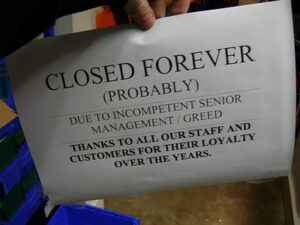Yesterday, I wrote about the origins of workforce development, and the apparent damage it has done to the middle class. Workforce development isn’t the only outcome Reagan’s reimagined Higher Education environment. Reagan’s budget cuts to programs like Pell Grants and the Guaranteed Student Loan Program fell heavily on middle class American households. These cuts made college more expensive and less accessible to income-limited students. (That – by the way – was the point.)
Reagan’s approach to higher education stems from the basic assumption that the only legitimate purpose for post-secondary education is preparation for work. The administration created a comfortable mechanism for corporate influence over public education. Reagan’s unstated implication was that public education’s primary role is to create employees for Corporate America.
Workforce development aims to do just this. Forty years later, Reagan’s influence is still alive and quite well. Earlier this week, Mott Community College announced a new program, “Workforce Promise.” The program allows employers to refer MCC graduates back to the school for further training at no cost.
For the last four decades, we have left workforce development running unattended. The result is that community college degrees and non-degree certificates are now indistinguishable from a high school diploma. Prospective students do not need to enroll in community college classes because community college administrators who find it more personally financially rewarding to hang out in Reagan’s 1950’s- era plutocracy have bargained away all benefits of attendance .
Since the 1980’s, community colleges have spent an inordinate amount of time and money taking marching orders from local employers. The problem, of course, is that three-fourths of businesses fail within 15 years, making most employers transient.
Workforce development weakens communities
This haphazard approach to “workforce development” creates workers whose skillsets are narrowly tailored to businesses that have a better chance of failing than succeeding. While businesses come and go with alarming regularity, workers do not. When a business closes its doors, it leaves behind workforce development victims with inflexible and incomplete skillsets. Additionally, the community’s investment in the “workforce development” of a closed or sold business is effectively zeroed out.
Further, business owners have an almost annoying tendency to sell their businesses to other businesses. The new ownership may have no interest in keeping the company as-is, where-is. Such a transaction invalidates the taxpayers’ investment in the education of the workforce. The employer-specific training may mean absolutely nothing if the new owner extends its own business practices to the newly acquired company.
A student who pays to attend a higher education institution has the right to expect that the institution’s primary interest is in satisfying the needs of the payer. Likewise, a community that heavily funds a higher education like a community college has the right to expect the community college to deliver some ongoing economic benefit to the district. This includes an employer only to the extent that the employer also pays taxes in support of the community college, but this does not vault the employers’ needs to the top of the institution’s priority list.
Higher education institutions should create programs that provide a high quality educational foundation that is flexible enough to enable the student/graduate to perform competently in a variety of roles. Community colleges cannot become so entwined with area employers that they fail to meet their primary objectives of serving the students and meeting the community’s long-term needs.
Photo Credit: Thomas Hawk, via Flickr































